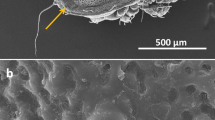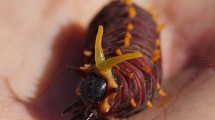Abstract
Most oribatid mites possess a pair of opisthonotal exocrine glands that produce mostly complex, species-specific secretions. Such blends may contain more than 10 different compounds, but hardly anything is known about their primary biosynthesis or regeneration. I analyzed recovery of the 6 main components from the 11-compound secretion of the oribatid mite Archegozetes longisetosus Aoki, including the main chemical classes hydrocarbons, aromatics, and terpenes, during a 20-day time course after complete gland depletion. About 10 % of the original total secretion amount was restored after 24 hr, and after 2–6 days, the amount had reached the range of total amount observed in the control group. Most compounds were recovered at similar rates within the first 48 hr. An important exception was pentadecane, which was predominantly produced in the first few hours, suggesting that this compound is the main solvent of the secretion. Although relative amounts of the main compounds differed significantly over time, the complex profile of the whole secretion was stable and not confidently distinguishable among the sampling dates. The general recovery rate was high during the first 48 hr, about 25 times higher than in the remaining 18 days. The biological importance of this high initial investment was supported by predation experiments: the predacious rove beetle Stenus juno was first repelled after 48 hr when at least 25 % of secretions was restored.






Similar content being viewed by others
References
Baldwin, I. T., Dusenbery, D. B., and Eisner, T. 1990. Squirting and refilling: Dynamics of p-benzoquinone production in defensive glands of Diploptera punctata. J. Chem. Ecol. 16:2823–2834.
Eisner, T. 2003. For Love of Insects. Harvard University Press, Cambridge.
Farine, J.-P., Everaerts, C., Abed, D., and Brossut, R. 2000. Production, regeneration and biochemical precursors of the major components of the defensive secretion of Eurycotis floridana (Dictyoptera, Polyzosteriinae). Ins. Biochem. Mol. Biol. 30:601–608.
Fescemyer, H. W. and Mumma, R. O. 1983. Regeneration and biosynthesis of dytiscid defensive agents (Coleoptera: Dytiscidae). J. Chem. Ecol. 9:1449–1464.
Hammer, O., Harper, D. A. T., and Ryan, P. D. 2001. PAST: Paleontological Statistics software package for education and data analysis. Palaeontol. Electron. 4:9.
Happ, G. and Meinwald, J. 1965. Biosynthesis of arthropod secretions. I. Monoterpene synthesis in an ant (Acanthomyops claviger). J. Am. Chem. Soc. 87:2507–2508.
Heethoff, M. and Raspotnig, G. 2011. Is 7-hydroxyphthalide a natural compound of oil-gland secretions? – Evidence from Archegozetes longisetosus (Acari, Oribatida). Acarologia 51:229–236.
Heethoff, M. and Raspotnig, G. 2012a. Expanding the ‘enemy-free space’ for oribatid mites: Evidence for chemical defense of juvenile Archegozetes longisetosus against the rove beetle Stenus juno. Exp. Appl. Acarol. 56:93–97.
Heethoff, M. and Raspotnig, G. 2012b. Triggering chemical defense in an oribatid mite using artificial stimuli. Exp. Appl. Acarol. 56:287–295.
Heethoff, M., Laumann, M., and Bergmann, P. 2007. Adding to the reproductive biology of the parthenogenetic oribatid mite, Archegozetes longisetosus (Acari, Oribatida, Trhypochthoniidae). Turk. J. Zool. 31:151–159.
Heethoff, M., Laumann, M., Weigmann, G., and Raspotnig, G. 2011a. Integrative taxonomy: Combining morphological, molecular and chemical data for species delineation in the parthenogenetic Trhypochthonius tectorum complex (Acari, Oribatida, Trhypochthoniidae). Front. Zool. 8:2.
Heethoff, M., Koerner, L., Norton, R. A., and Raspotnig, G. 2011b. Tasty but protected - First evidence of chemical defense in oribatid mites. J. Chem. Ecol. 37:1037–1043.
Kuwahara, Y. 2004. Chemical ecology of astigmatid mites, pp. 76–109, in R. T. Cardé and J. G. Millar (eds.), Advances in Insect Chemical Ecology. Cambridge University Press, Cambridge.
Mizoguchi, A., Mori, N., Nishida, R., and Kuwahara, Y. 2003. α-acaridial a female sex pheromone from an alarm pheromone emitting mite Rhizoglyphus robini. J. Chem. Ecol. 29:1681–1690.
Morita, A., Mori, N., Nishida, R., Hirai, N., and Kuwahara, Y. 2004. Neral (the alarm pheromone) biosynthesis via the mevalonate pathway, evidence by D-glucose-1-13C feeding in Carpoglyphus lactis and 13C incorporation into other opisthonotal gland exudates. J. Pestic. Sci. 29:27–32.
Noge, K., Kato, M., Iguchi, T., Mori, N., Nishida, R., and Kuwahara, Y. 2005. Biosynthesis of neral in Carpoglyphus lactis (Acari: Carpoglyphidae) and detection of its key enzyme, geraniol dehydrogenase, by electrophoresis. J. Acarol. Soc. Jpn. 14:75–81.
Noirot, C. and Quennedy, A. 1974. Fine structure of insect epidermal glands. Annu. Rev. Entomol. 19:61–80.
Norton, R. A. 1998. Morphological evidence for the evolutionary origin of Astigmata. Exp. Appl. Acarol. 22:559–594.
Peschel, K., Norton, R. A., Scheu, S., and Maraun, M. 2006. Do oribatid mites live in enemy-free space? Evidence from feeding experiments with the predatory mite Pergamasus septentrionalis. Soil Biol. Biochem. 38:2985–2989.
Raspotnig, G. 2006. Chemical alarm and defence in the oribatid mite Collohmannia gigantea (Acari: Oribatida). Exp. Appl. Acarol. 39:177–194.
Raspotnig, G. 2010. Oil gland secretions in Oribatida (Acari), pp. 235–239, in M. W. Sabelis and J. Bruin (eds.), Trends in Acarology. Springer, Dordrecht.
Raspotnig, G., Norton, R.A. and Heethoff, M. 2011a. Oribatid mites and skin alkaloids in poison frogs. Biol. Lett. 7:555–556.
Raspotnig, G., Leutgeb, V., Krisper, G., and Leis, H.-J. 2011b. Discrimination of Oribotritia species by oil gland chemistry (Acari, Oribatida). Exp. Appl. Acarol. 54:211–224.
Sakata, T. and Norton, R. A. 2001. Opisthonotal gland chemistry of early-derivative oribatid mites (Acari) and its relevance to systematic relationships of Astigmata. Int. J. Acarol. 27:281–291.
Schulz, S. 2001. Selectivity in chemical communication systems of arthropods, pp. 237–252, in F. G. Barth and A. Schmid (eds.), Ecology of Sensing. Springer, Berlin.
Tomita, A., Shimizu, N., Mori, N., Nishida, R., Nakao, H., and Kuwahara, Y. 2003. Chemical ecology of astigmatid mites. LXXI. Neryl formate (Z)-3,7-dimethyl-2,6-octadienyl formate as the alarm pheromone of Tyroborus lini Oudemans 1924, and its recovery after forced discharge. J. Acarol. Soc. Jpn. 12:11–19.
Acknowledgements
I thank Günther Raspotnig and Roy Norton for their comments, Paavo Bergmann for information on oil-gland ultrastructure, and Lars Koerner for providing Stenus juno specimens for predation experiments and comments on the manuscript. This study was funded by the German Science Foundation (DFG-Forschungsstipendium HE4593/3-1) and supported by the Styrian language exchange service POTSCHASN (represented by Anna Truck).
Author information
Authors and Affiliations
Corresponding author
Rights and permissions
About this article
Cite this article
Heethoff, M. Regeneration of Complex Oil-Gland Secretions and Its Importance for Chemical Defense in an Oribatid Mite. J Chem Ecol 38, 1116–1123 (2012). https://doi.org/10.1007/s10886-012-0169-8
Received:
Revised:
Accepted:
Published:
Issue Date:
DOI: https://doi.org/10.1007/s10886-012-0169-8




